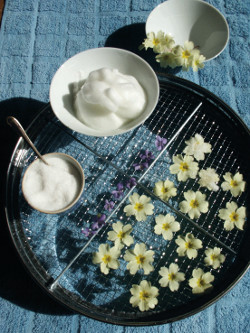Wild Primrose & Wild Sweet Violet
 Wild herbs and edible flowers are a great addition to any kitchen and Biddy White Lennon and Evan Doyle devote a chapter of ‘Wild Food’ to these charmingly pretty and colourful foods.
Wild herbs and edible flowers are a great addition to any kitchen and Biddy White Lennon and Evan Doyle devote a chapter of ‘Wild Food’ to these charmingly pretty and colourful foods.
Wild Primrose (Primula vulgaris *Irish sabhaircin) and Wild Sweet Violet & (Viola odorata * Irish sail-chuach chumhra) are low-growing, common and easily found in woodland, hedgerows, and banks in spring and summer time. Violet leaves are almost evergreen while the primrose dies back after flowering.
A feature of both is that during their season the more you pick the more flowers grow. The leaves and flowers of both are edible and have a wonderful perfume. Use fresh to add colour and flavour to salads, desserts and drinks. There is along tradition of crystallising them for decorating cakes.
 CRYSTALLISED PRIMROSES OR VIOLETS
CRYSTALLISED PRIMROSES OR VIOLETS
A labour of love, this recipe is for those with patience and steady hands. The result makes stunning decorations for cakes, desserts such as ice cream, syllabub, fruit salads and fruit tarts. You may wish to keep small children away as they are so delicious they eat them as fast as you make them.
A small basket of either flower, or both
2 egg whites
Caster sugar as needed
A small flat-shaped paint brush
A pair of tweezers
A wire rack for drying the flowers
Discard any flowers that are bruised or misshapen. Take each flower and remove all the stem and any green material at the base. Make sure the flowers are completely dry. Beat the egg white until frothy. Set up a production line. Flowers, egg white and sugar.
Grip the base of each flower and ‘paint’ each flower on both sides with the frothy egg white. Dip the brush into the caster sugar and paint each flower, making sure the surface of the flower is fully coated with sugar. You may use a sugar shaker or a teaspoon to sugar any part of the flower that has been missed in the dipping process.
Carefully place each flower base-side downwards on the wire rack. Dry in a warm place. If the air is high in humidity, place them in an oven set to the lowest possible temperature with the oven door slightly open.
Store the dried flowers, interleaved with tissue paper or waxed paper, in a box or wide-necked jar. Store in a dark dry place.





There are currently no comments
Leave a comment
Not a member? Register for your free membership now!
Or leave a comment by logging in with: